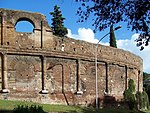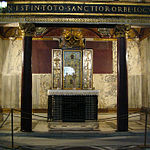Aqua Appia
310s BC establishments312 BC4th century BC in ItalyAncient Roman aqueducts in RomeBuildings and structures completed in the 4th century BC

The Aqua Appia was the first Roman aqueduct, constructed in 312 BC by the co-censors Gaius Plautius Venox and Appius Claudius Caecus, the same Roman censor who also built the important Via Appia.The Appia fed the city of Rome with an estimated 73,000 cubic metres (2,600,000 cu ft) of water per day.
Excerpt from the Wikipedia article Aqua Appia (License: CC BY-SA 3.0, Authors, Images).Aqua Appia
Piazza di Santa Croce in Gerusalemme, Rome Municipio Roma I
Geographical coordinates (GPS) Address Nearby Places Show on map
Geographical coordinates (GPS)
| Latitude | Longitude |
|---|---|
| N 41.889444444444 ° | E 12.511111111111 ° |
Address
Aqua Neroniana
Piazza di Santa Croce in Gerusalemme
00182 Rome, Municipio Roma I
Lazio, Italy
Open on Google Maps










